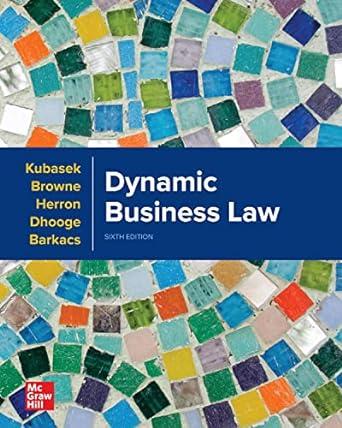Respondents Varsity Brands, Inc., Varsity Spirit Corporation, and Varsity Spirit Fashions & Supplies, Inc., design, make, and
Question:
Respondents Varsity Brands, Inc., Varsity Spirit Corporation, and Varsity Spirit Fashions & Supplies, Inc., design, make, and sell cheerleading uniforms.
Respondents have obtained or acquired more than 200 US copyright registrations for two-dimensional designs appearing on the surface of their uniforms and other garments. These designs are primarily “combinations, positionings, and arrangements of elements” that include “chevrons … , lines, curves, stripes, angles, diagonals, inverted [chevrons], coloring, and shapes.” Five of these copyrights are the subject of this case.
Petitioner Star Athletica, L.L.C., also markets and sells cheerleading uniforms. Respondents sued petitioner for infringing their copyrights for the five designs. The district court entered summary judgment for petitioner on respondents’ copyright claims on the ground that the designs did not qualify as protectable pictorial, graphic, or sculptural works. It reasoned that the designs served the useful, or “utilitarian,” function of identifying the garments as “cheerleading uniforms” and therefore could not be “physically or conceptually” separated under §101 “from the utilitarian function” of the uniform.
The Court of Appeals for the Sixth Circuit reversed, finding that the graphic designs were separately identifiable because the designs and a blank cheerleading uniform can appear side by side—one as a graphic design, and one as a cheerleading uniform. The court also found that the designs were “capable of existing independently because they could be incorporated onto the surface of different types of garments, or hung on the wall and framed as art."
JUSTICE THOMAS We granted certiorari to resolve widespread disagreement over the proper test for implementing §101’s separate identification and independent-existence requirements…. We hold that a feature incorporated into the design of a useful article is eligible for copyright protection only if the feature (1) can be perceived as a two- or three-dimensional work of art separate from the useful article and (2) would qualify as a protectable pictorial, graphic, or sculptural work—either on its own or fixed in some other tangible medium of expression—if it were imagined separately from the useful article into which it is incorporated…
As an initial matter, we must address whether separability analysis is necessary in this case.
The statute requires separability analysis for any “pictorial, graphic, or sculptural features” incorporated into the “design of a useful article.” “Design” refers here to “the combination” of “details” or “features” that “go to make up” the useful article. … Furthermore, the words “pictorial” and “graphic” include, in this context, two dimensional features such as pictures, paintings, or drawings. …. And the statute expressly defines “pictorial, graphical, and sculptural works” to include “two dimensional … works of … art.” … The statute thus provides that the “design of a useful article” can include two-dimensional “pictorial” and “graphic” features, and separability analysis applies to those features just as it does to three-dimensional “sculptural” features.
We must now decide when a feature incorporated into a useful article “can be identified separately from” and is “capable of existing independently of” “the utilitarian aspects” of the article…. We thus begin and end our inquiry with the text, giving each word its “ordinary, contemporary, common meaning.”… The first requirement—separate identification—is not onerous. The decisionmaker need only be able to look at the useful article and spot some two- or three dimensional element that appears to have pictorial, graphic, or sculptural qualities…. The independent-existence requirement is ordinarily more difficult to satisfy. The decisionmaker must determine that the separately identified feature has the capacity to exist apart from the utilitarian aspects of the article. If the feature is not capable of existing as a pictorial, graphic, or sculptural work once separated from the useful article, then it was not a pictorial, graphic, or sculptural feature of that article, but rather one of its utilitarian aspects….
The ultimate separability question, then, is whether the feature for which copyright protection is claimed would have been eligible for copyright protection as a pictorial, graphic, or sculptural work had it originally been fixed in some tangible medium other than a useful article before being applied to a useful article….
Applying this test to the surface decorations on the cheerleading uniforms is straightforward. First, one can identify the decorations as features having pictorial, graphic, or sculptural qualities. Second, if the arrangement of colors, shapes, stripes, and chevrons on the surface of the cheerleading uniforms were separated from the uniform and applied in another medium—for example, on a painter’s canvas—they would qualify as “two-dimensional … works of … art,”
And imaginatively removing the surface decorations from the uniforms and applying them in another medium would not replicate the uniform itself. Indeed, respondents have applied the designs in this case to other media of expression—different types of clothing—without replicating the uniform. The decorations are therefore separable from uniforms and eligible for copyright protection.
We hold that an artistic feature of the design of a useful article is eligible for copyright protection if the feature (1) can be perceived as a two- or three dimensional work of art separate from the useful article and (2) would qualify as a protectable pictorial, graphic, or sculptural work either on its own or in some other medium if imagined separately from the useful article. Because the designs on the surface of respondents’ cheerleading uniforms in this case satisfy these requirements, the judgment of the Court of Appeals is affirmed.
Affirmed in favor of Respondents.
CRITICAL THINKING:
Do you agree with the ruling of the court in this case? Why or why not? Can you foresee any difficulties in applying the test that the court says it is establishing to clear up confusion among the lower courts?
ETHICAL DECISION MAKING:
What values are furthered by the outcome of this case?
Step by Step Answer:

Dynamic Business Law
ISBN: 9781260733976
6th Edition
Authors: Nancy Kubasek, M. Neil Browne, Daniel Herron, Lucien Dhooge, Linda Barkacs





